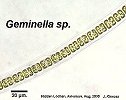FILAMENTOUS ALGAL SPECIES COMMON IN ACID AND SOFT WATERS.
Descriptions of operational taxa found in field studies in Scotland.
(Loch
Ard area of The Trossachs, Galloway, Islay, Morar and Glenelg:
Kinross, 1985, 1991 and unpublished data)
LIST
Ulotrichales:Geminella
Hormidium (Klebsormidium)
Ulothrix
Taxon no. (1-50 as referred to in Kinross et al, 1993)
Ulotrichales
39, 40 = Geminella species* 8Ám and 11Ám.
This genus is
distinguished by the possession of a mucilage sheath, described as wide
by Prescott (1970), but in the two examples found in the Loch Ard area the
sheath is relatively narrow. The filaments resemble Ulothrix species,
but the cell walls are very indistinct so that the appearance is of Ulotrichoid
chloroplasts strung together in a clear refractile tube. 
*Some samples may be Ulothrix zonata (B. Lokhorst, pers.comm.) In nutrient depleted conditions the cells may become widely separated within a clear matrix. In this form they resemble the genus Binuclearia. and in some cases may have been Binuclearia (B. Lokhorst, pers.comm.)
However, as this morphology is only found in senscent samples (e.g. old cultures or field samples gathered in summer), I have been reluctant to ascribe any samples to the genus Binuclearia and adopted the working designations Geminella 8Ám. and Geminella 11Ám. during the Loch Ard studies. They may be size variants of the same species as Ulothrix zonata is very variable (B. Lokhorst, pers.comm.).
Taxa encountered in other areas are:
59 = Geminella 30Ám.
60 = Geminella 48Ám.
61 = Geminella 75Ám.
These are likewise probably size variants of U. zonata
41, 42 = Hormidium
(Klebsormidium) species 
more.. (use your browser back button to return here)
Two taxa are recognized, modal cell diameters approximately 5.5Ám. and 8Ám. They have long filaments of cylindrical cells, not usually constricted at cross-walls. Taxon 41 ranges from 5 to 7 Ám. diameter and taxon 42 ranges from 7 to 9 Ám., so there is a degree of overlap and if only one is present in a sample it may not be possible to unequivocally ascribe it to the 'correct' taxon. These are operational taxa and may both belong to the same species.
The cells are 1-2 times as long as broad, occasionally longer. The cell wall is thin, with no sheath. The chloroplast is a parietal disc, covering about half the circumference and 50-100% of the cell length. Frequently two chloroplasts per cell are found, especially in the longer cells (longer than 2 cell diameters).
In a nutrient depleted culture this form of the chloroplast is easily seen, but in a fresh culture or in nutrient sufficient conditions in field samples the chloroplast is enlarged and may appear more Ulotrichoid. In nutrient depleted conditions the cytoplasm is also seen to be more granular in appearance and the cells tend to be longer.
These taxa have cylindrical cells forming long unbranched filaments. The chloroplast is a parietal ring, which is incomplete in the smaller taxa, covering about half the circumference and the full length of the cell. I have designated as Ulothrix any specimens which appear to have no sheath, but a clearly defined cell wall, in contrast to Geminella spp. There is thus a great deal of overlap possible with the Hormidium species described above. Taxa ascribed to the genus Ulothrix have the following descriptions and dimensions:
43 = 8Ám. diameter; may not be a separate species from 42, and is distinguished only by appearing 'more Ulotrichoid'.
44 = 10Ám.
diameter. Similar in appearance to the last taxon, but larger. The chloroplast
occupies the full length of the cell.
45 = 10-11Ám.
diameter, with walls frequently bearing plates or scales of thickened material,
often coloured deep brown so that the cell contents are obscured. The form
of the chloroplast is similar to the previous taxon. This is Klebsormidium crenulatum ,
but the operational designation 'Ulothrix 10Ám. scaly' was used in community structure analysis.
46 = 14Ám. diameter, chloroplast a complete ring.
47 = 17Ám. diameter, chloroplast a complete ring.
48 = 25-30Ám. diameter, chloroplast a complete ring.
49 = 36Ám. diameter, chloroplast a complete ring.
The last four taxa are uncommon in L. Ard samples. All may be Ulothrix zonata (B. Lokhorst, pers comm.)
John Kinross

